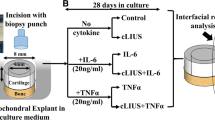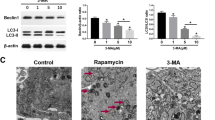Abstract
Purpose
Clematis chinensis Osbeck (CCO) is an essential herb that has been shown to promote the biological functions of cartilage cells. In this study, we aimed to explore whether and how low-intensity pulsed ultrasound (LIPUS) enhanced CCO delivery into chondrocytes and stimulated biological activity in vitro.
Methods
Chondrocytes were isolated from knee articular cartilage of 2-week-old rabbits and treated with LIPUS plus CCO or recombinant transforming growth factor beta 1 (TGF-β1; 0.5 ng/mL), with or without anti-TGF-β1 antibodies (10 μg/mL), for 3 days. Cell proliferation was assessed by Cell-Counting Kit-8 assays. Immunocytochemistry, western blotting, and quantitative polymerase chain reaction were applied to detect the expression of type II collagen and some molecules in the TGF-β1 signal pathway.
Results
LIPUS plus 0.1 mg/mL CCO solution promoted chondrocyte proliferation and type II collagen and TGF-β1 expression synergistically in vitro (P < 0.05). In addition, treatment with anti-TGF-β1 antibodies blocked this effect (P < 0.01), but not completely. CCO plus LIPUS also showed more enhanced effects on promoting TGF-β receptor II and Smad2 signaling and reducing Smad7 signaling than either intervention separately (P < 0.05).
Conclusions
CCO plus LIPUS promoted extracellular matrix deposition by accelerating the TGF-β/Smad-signaling pathway in chondrocytes.






Similar content being viewed by others
References
Kane P, Frederick R, Tucker B, et al. Surgical restoration/repair of articular cartilage injuries in athletes. Phys Sportsmed. 2013;2:75–86.
Green WT Jr. Articular cartilage repair. Behavior of rabbit chondrocytes during tissue culture and subsequent allografting. Clin Orthop Relat Res. 1977;124:237–50.
Gaut C, Sugaya K. Critical review on the physical and mechanical factors involved in tissue engineering of cartilage. Regen Med. 2015;5:665–79.
Responte DJ, Lee JK, Hu JC, et al. Biomechanics-driven chondrogenesis: from embryo to adult. FASEB J. 2012;9:3614–24.
Zhang M, Chen FM, Chen YJ, et al. Effect of mechanical pressure on the thickness and collagen synthesis of mandibular cartilage and the contributions of G proteins. Mol Cell Biomech. 2011;1:43–60.
Brandl A, Angele P, Roll C, et al. Influence of the growth factors PDGF-BB, TGF-beta1 and bFGF on the replicative aging of human articular chondrocytes during in vitro expansion. J Orthop Res. 2010;3:354–60.
Shi S, Chan AG, Mercer S, et al. Endogenous versus exogenous growth factor regulation of articular chondrocytes. J Orthop Res. 2014;1:54–60.
Du J, Huang YP, Li YX, et al. Effect of GUILU ERXIAN gelatin and its formula components on the concentrations of serum estradiol and expressions of Collagen II in the chondrocytes of knee joint for ovariectomized rats with osteoarthritis (In Chinese). J Tradit Chin Orthop Traumatol. 2013;3:11–20.
Xu XX, Zhang XH, Diao Y, et al. Achyranthes bidentate saponins protect rat articular chondrocytes against interleukin-1β-induced inflammation and apoptosis in vitro. Kaohsiung J Med Sci. 2017;2:62–8.
Liu F, Weng X, Lin P, et al. Duhuo Jisheng decoction inhibits endoplasmic reticulum stress in chondrocytes induced by tunicamycin through the downregulation of miR-34a. Int J Mol Med. 2015;5:1311–8.
Ma Y, Wu J. Prescription analysis of TCM on knee osteoarthritis (In Chinese). Zhongguo Zhongyi Gushangke Zazhi. 2005;12:58–9.
Ma Y, Zhang YS, Chen JF, et al. Effect of Weilingxian on proliferation of rabbit knee articular chondrocyte cultured in vitro and mRNA expression of TGFβ1 (In Chinese). Zhongguo Zuzhi Gongcheng Yanjiu yu Linchuang Kangfu. 2010;11:1901–6.
Ma Y, Chen JF, Zhang YS, et al. Repair of rabbit articular cartilage defect by the injectable chitosan/beta-glycerophosphate gel encapsulating allograft chondrocytes and the intervention of Weilinxian (In Chinese). Zhongguo Zuzhi Gongcheng Yanjiu yu Linchuang Kangfu. 2010;16:2864–9.
Loyola-Sánchez A, Richardson J, Beattie KA, et al. Effect of low-intensity pulsed ultrasound on the cartilage repair in people with mild to moderate knee osteoarthritis: a double-blinded, randomized, placebo-controlled pilot study. Arch Phys Med Rehabil. 2012;93:35–42.
Rothenberg J, Jayaram P, Naqvi U, et al. The role of low-intensity pulsed ultrasound on cartilage healing in knee osteoarthritis: a review. PM R. 2017;9:S1934-1482(16)31010-3.
Ma Y, Guo Y, Tu J, et al. Effect of low-intensity pulsed ultrasound mediated Clematis chinensis Osbeck on the proliferation and expression of type II collagen and transforming growth factor-beta1 of rabbit knee articular chondrocytes (In Chinese). Zhongguo Zuzhi Gongcheng Yanjiu. 2014;38:6110–5.
Qi J, Zhang YK. The research of cartilage degenerative osteoarthritis (In Chinese). Med Recapitulate. 2012;3:404–6.
Jonitz A, Lochner K, Tischer T, et al. TGF-beta1 and IGF-1 influence the re-differentiation capacity of human chondrocytes in 3D pellet cultures in relation to different oxygen concentrations. Int J Mol Med. 2012;3:666–72.
Chu LT, Lu Y, Deng YJ, et al. Research on prescriptions of modern treatment for Gu Bi (osteoarthritis) (In Chinese). J Guangzhou Univ Tradit Chin Med. 2012;4:466–9.
Zhang YF, Wang JW, Ma Y, et al. Therapeutic effect of medical ozone combined with Weilinxian on knee osteoarthritis (In Chinese). J Liaoning Univ TCM. 2013;4:174–6.
Shahin K, Doran PM. Tissue engineering of cartilage using a mechanobioreactor exerting simultaneous mechanical shear and compression to simulate the rolling action of articular joints. Biotechnol Bioeng. 2012;4:1060–73.
Loyola-Sanchez A, Richardson J, Beattie KA, et al. Effect of low-intensity pulsed ultrasound on the cartilage repair in people with mild to moderate knee osteoarthritis: a double-blinded, randomized, placebo-controlled pilot study. Arch Phys Med Rehabil. 2012;1:35–42.
Azagury A, Khoury L, Enden G, et al. Ultrasound-mediated transdermal drug delivery. Adv Drug Deliv Rev. 2014;72:127–43.
Koebis M, Kiyatake T, Yamaura H, et al. Ultrasound-enhanced delivery of morpholino with Bubble liposomes ameliorates the myotonia of myotonic dystrophy model mice. Sci Rep. 2013;3:2242.
Weiss A, Attisano L. The TGF-beta superfamily signaling pathway. Wiley Interdiscip Rev Dev Biol. 2013;1:47–63.
Santibañez JF, Quintanilla M, Bernabeu C. TGF-β/TGF-β receptor system and its role in physiological and pathological conditions. Clin Sci (Lond). 2011;6:233–51.
Cheng X, Alborzinia H, Merz KH, et al. Indirubin derivatives modulate TGFβ/BMP signaling at different levels and trigger ubiquitin-mediated depletion of nonactivated R-Smads. Chem Biol. 2012;11:1423–36.
Chen W, Fu X, Sheng Z. Review of current progress in the structure and function of Smad proteins. Chin Med J(Engl). 2002;3:446–50.
Ab-Rahim S, Selvaratnam L, Raghavendran HR, et al. Chondrocyte-alginate constructs with or without TGF-β1 produces superior extracellular matrix expression than monolayer cultures. Mol Cell Biochem. 2013;1–2:11–20.
Acknowledgements
This study was financially supported by the National Natural Science Foundation of China (No. 81673995), Natural Science Foundation for Youths of Jiangsu Province, China (No. BK20151007), Natural Science Foundation of Jiangsu Province, China (No. BK2011812, No. BK20161047), and Postgraduate Research & Practice Innovation Program of Jiangsu Province (KYCX17_1308).
Author information
Authors and Affiliations
Corresponding author
Ethics declarations
Ethical statements
All experimental procedures were approved by the institutional and local committee on the care and use of animals of Nanjing University of Chinese Medicine.
Conflict of Interest
The authors declare that they have no conflicts of interest.
About this article
Cite this article
Pan, Yl., Ma, Y., Guo, Y. et al. Effects of Clematis chinensis Osbeck mediated by low-intensity pulsed ultrasound on transforming growth factor-β/Smad signaling in rabbit articular chondrocytes. J Med Ultrasonics 46, 177–186 (2019). https://doi.org/10.1007/s10396-018-0920-z
Received:
Accepted:
Published:
Issue Date:
DOI: https://doi.org/10.1007/s10396-018-0920-z




